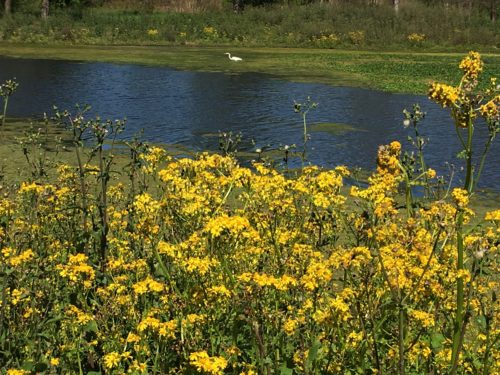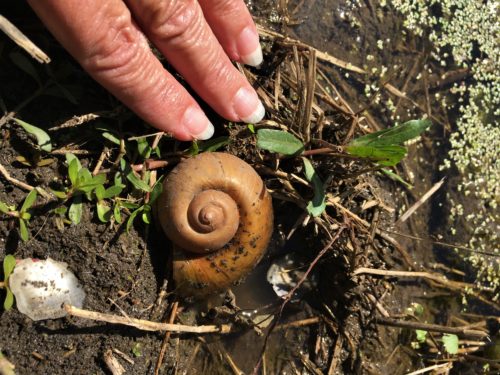Bayou Segnette State Park, Westwego, Louisiana (New Orleans)

This morning’s view!
Pretty big yard we have this week!
Note the spring buds on the tree outside the window!
Beautiful morning! Signs of Spring are all around us! The trees are budding (well actually, most are in full leaf), the birds are singing, the frost on the roof of the Jeep is thawing, the weed-whackers and trucks are saturating the air with sound . . . Wait! What? Yep. We’re sitting in an isolated sight, but somewhere just on the other side of the trees in our backyard, sits some kind of facility that uses trucks from 7am to 5pm. And the campground’s ground crew came around at 8am to begin whacking and mowing. But it’s super quiet after 5pm and extremely dark once the sun goes down! 😊
Did you happen to notice the unusual name of the town we’re in? So how would you pronounce it? West We Go! West WAY go? WEST we go?
It’s actually westWEgo. Of course I needed to know where that name came from! Here’s what the town’s website says:
The City developed around the Mississippi River, the railroad, and the Westwego canal that once connected with the river through locks, Bayou Segnette, and the swamp and marshes south of the city that connected it to the rich wildlife and fishing areas of the Barataria basin. Westwego was founded in 1870 by the Texas and Pacific Railroad when it placed a railroad yard and docks on the Mississippi River just above the canal linking the river to Bayou Segnette, Bayou Lafourche then to the Gulf of Mexico. It grew to eventually incorporate the village of Salaville, Seven Oaks Plantation, Whitehouse Plantation, and surrounding farmland.
No one is quite sure how the town got its name, though Westwego was the location from which the railroad was compensated by the State to build a railroad to the west. Folklore holds that as travelers departed the station they heard the conductor yell “west we go”. A railroad engineer, G. W. R. Bayley, first publicized the name in 1873 when he wrote, “The construction of the railroad west of New Orleans was commenced at Westwego, opposite the Western boundary of the city (New Orleans), in the latter part of May 1870.”
Tradition
A large portion of the early residents were fishermen, shrimpers, oystermen, and trappers, the city being on the fastest route for seafood to come from the Gulf and Barataria Basin to the markets of New Orleans. In 1893, a hurricane devastated a small fishing village on Cheniere Caminada, a small barrier island west of Grand Isle, with great loss of life. Many survivors moved their families to Westwego since it was a safer location far from the gulf. The introduction of motorized boats resulted in more residents and further development of marine related businesses.
Family
Many early residents are descendants of the African-American, German, and Italian settlers that resided in the city. The Cheniere Caminada refugees of French heritage were the largest of the population in the city after 1893. It is still possible to hear French spoken among the residents. Their pride of, and concern about, family run deep and is evidenced by their support of family activities and recreational events that abound in Westwego.
So, what shall we do today? Hmmm . . . let’s see . . .
I think we’ll take it a bit easy today. Laze around the coach, take a bike tour around the Park, walk a few trails.

Our new neighbors!
They put this up last night.
Weirdest thing we’ve ever seen! And yes. There’s a tent ON TOP of their SUV!
They were gone when we returned, so I wasn’t able to get a good picture. The other side actually had a ladder!

This is a conference center of some kind. There are rooms and a kitchen. That’s all we know.

Wave Pool!
They locked us out.
No proper swim attire! : )
Actually, they’re not open for the season yet.

Sound like fun to you?
Not me!
Many years ago, the first time I visited one of these, I almost drowned. Never again. : )




This lovely area is right beside the pool!

Further down the road
This would be great to kayak on!

There were several bridges like this one.



Nice picnic area!

We got a call from one of our sons here.
While Blaine waited up top, I explored under the bridge.


You can find cool things when you’re just hanging out!


We ran across the other pool area.
It’s gonna need a lot of clean up before anyone can use it!

Then, we ran across this!
The Great Wall
This wall is all post-Katrina to try to eliminate the broken levy issues they had that caused much of the flooding at that time when 80% of the city was underwater. In fact, almost everything except the French Quarter flooded, since it sits on higher ground.

Looking toward the campground.

And we found out where the trucks are going!
Blaine thinks they’re building a levey around the town.

Look at this massive door!
I’ll never get it open that way.
Mostly because it’s a swing door, not a push one. : )

This “river”? runs alongside the road we’re biking on.
This is where the airboats run.

Blaine took this picture.
It’s something electrical . . . : )
But you can also see the cottages. They’re newer and are built like a floating dock.

The beginning of the trail

As we were biking, we kept seeing these things that looked like cow patties all over the place. We knew there were no cows around, so what are they? Then we ran across a couple during our hike, and up close, it got even more interesting.

Any guesses as to what this is??
Turns out, they’re crawfish chimneys! But not the kind you eat. Apparently, they’re a nuisance around this area and pop up in people’s yards. According to the site I visited, the way to get rid of them is with a tablespoon of lye in the hole.
That’s enough for today.
The next two days will be really busy and long!
TOTAL HIKING MILES: 2
Year To Date: 224
Daily Average: 2.80
